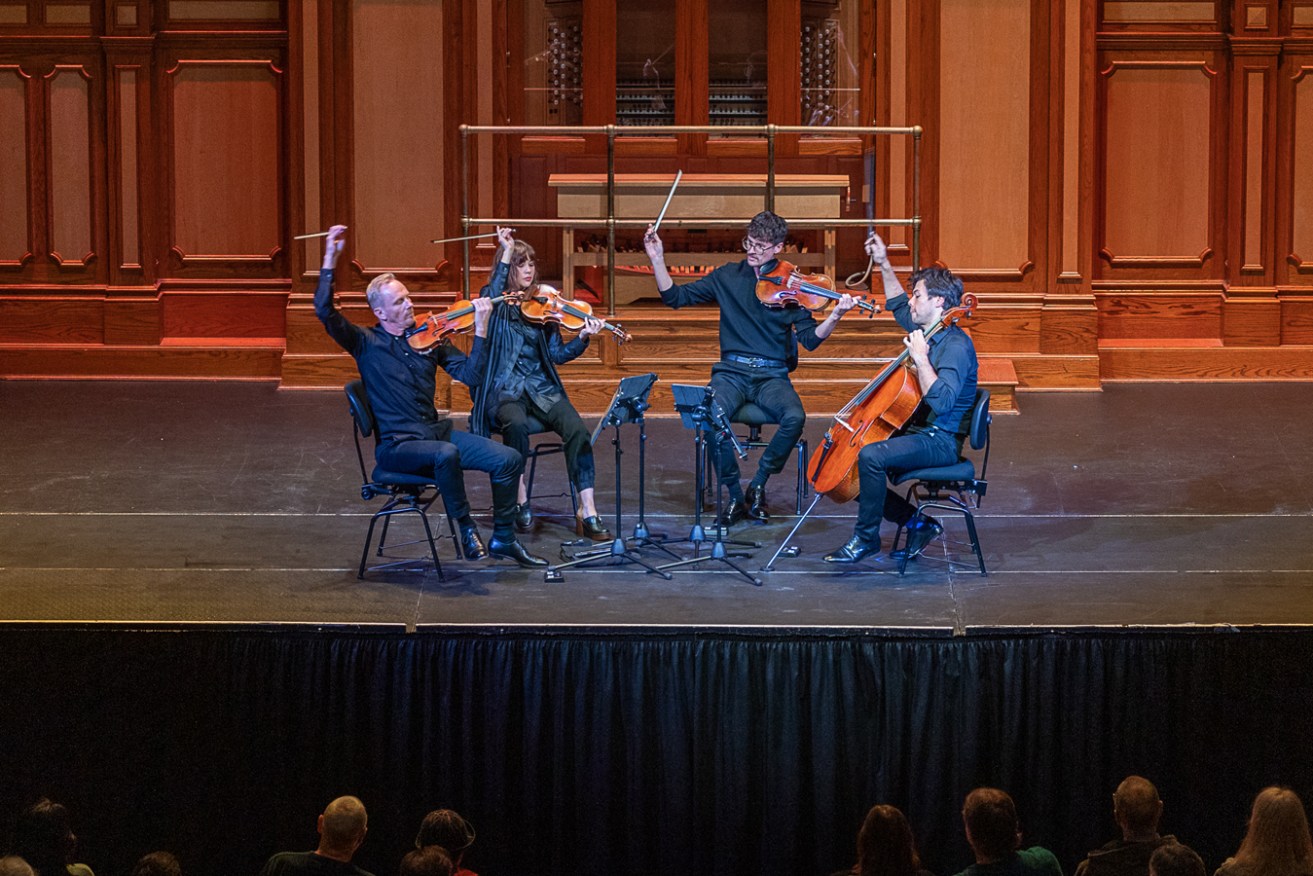Music review: ASQ’s Utopias
This Australian String Quartet concert presented not one but seven intriguing representations of paradise on Earth in Arcadiana by Thomas Adès, and saw them in blistering form with Shostakovich.


The Australian String Quartet perform 'Utopias' at the Adelaide Town Hall. Photo supplied
With their return home following a month on the road, it seemed fitting to check out what the Australian String Quartet have been up to during their latest tour, Utopias. Curiosity alone over its title could have been enough to draw interest. What it suggested was that this concert would take us to somewhere special indeed, for utopia must be that: one supposedly perfect place on Earth.
It took us to seven. Thomas Adès, that much-admired British composer whose works are heard increasingly in concert halls there and rather more here as well (his viola and piano pieces from The Exterminating Angel were played last October at UKARIA, arguably a miniature utopia itself), made his name partly from his string quartet piece Arcadiana in 1998. Each of its seven movements is a different representation of paradise, eliciting images of water and depicting scenes of the Idyll in ancient Greek mythology while quoting themes from Mozart, Schubert and Wagner – yet more intriguing.
They are all distinct from one another, but in sum Arcadiana presents the ear with a phantasmagoria of sounds and techniques that define where the modern string quartet lies in the present time. The first movement, “Venezia notturna” (“Venice by night”), consists of thin shafts of sound against which a lonely viola part slowly wanders about on its own; the second movement, “Das klinget so herrlich, das klinget so schön” (“That sounds so wonderful, that sounds so beautiful”), effervesces with high, sliding pitches and pizzicato cello, while the third, “Auf dem Wasser zu singen” (“On the water to sing”), glides with an overlay of longer bow strokes. Allusions to Wagner can be heard at one point in the fourth movement, “L’Embarquement”, which is reputedly inspired by a Watteau painting.
So these movement evoke various images in the mind, and perhaps memories, too, but in a disconnected way as if in a dream. That is, until what seems the heartland of Arcadiana is reached in the second-last movement, “O Albion”. This is a rapturous, deeply expressive elegy distinguished by a three-note sighing motif that gets passed around the ensemble. A final ghostly image occurs in the seventh movement, “Lethe”, when the instruments slowly spin away from each other and fade into silence.
What it all tantalisingly amounts to is no actual answers. Paradise is never found. Perhaps that’s its point. However, along the way are extraordinary sounds, and right here we were treated to extraordinary playing from the ASQ. Playing at the peak of virtuosity, they relished the work’s virtuosic demands. Their speed, delicacy and finesse are at a level they can call their own. I’ve never heard them play better.
It was a somewhat different situation with Mozart’s String Quartet No.15 in D minor, K.421. As witnessed with their Beethoven last year (Op.131), the ASQ seemed again to consciously employ interpretative ideas and techniques gained from playing contemporary works to inform more established works of the repertoire – albeit unusual in this case, for the fact that K.421 is one of only two quartets by Mozart to be in a minor key. Avoiding the pedestrian, the musicians were light, wispy and ultra-shaped in phasing, but at the same time curiously lacking a centre. When the exposition repeat came along in the first movement, things felt more grounded.
Later into this Mozart quartet there really are some peculiarities that separate him from Haydn, to whom he rather humbly dedicated this plus five other quartets. Modern-sounding octave doublings in the violins, foxy repeated rhythms, and a tendency towards the extremely pithy are things one notices. On this side of the ledger, the ASQ were fabulous, spotting what to bring out and distilling it to perfection. The viola variation in K.421’s final Allegretto movement was the most moving moment: with violist Christopher Cartlidge taking the melody, the ensemble opened up and Mozart gave a glimpse of his soul.
With Shostakovich, you kind of know what to expect: morbid undercurrents broken by sarcasm that verges on brutality. String Quartet No.9 in E-flat Major, Op.117, certainly calls for all this. ASQ did a lot more, though. The subdued world from which this quartet slowly emerges at the beginning had a highly crafted beauty in their hands that made the heavy contrasts that eventually arise even stronger. Their carefully honed playing drew out many more aspects of this work than one might have known existed, especially in Dale Barltrop’s winding, snaking lines that add layers of mystery to this work.
This was a gripping performance of great musical insight and technical accomplishment. One could continually admire the players’ elasticity of line, the blended sheen of their four instruments, and the sheer savagery of plucked chords that punctuate this work’s prevailing gloom. Shostakovich cannot exactly be overplayed to achieve effect, but the ASQ do so much more in the transparency and care of their playing. An astonishingly virtuosic swirl of lines and hammering of rhythm in the closing bars made this one of the group’s finest ever performances.
The Australian String Quartet presented Utopias at the Adelaide Town Hall on May 22. Their second concert tour for this year, Florescence, brings them back to the Adelaide Town Hall on August 17. Meanwhile, in a partnership with Nexus Arts, they are also presenting a series of performances with shamisen virtuoso Noriko Tadano next month at Aldinga, Mt Barker and Port Adelaide (details here).




